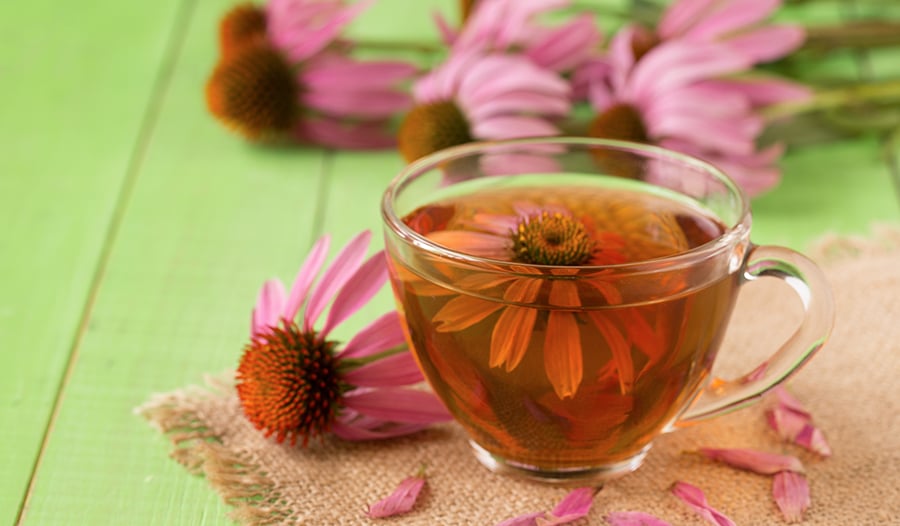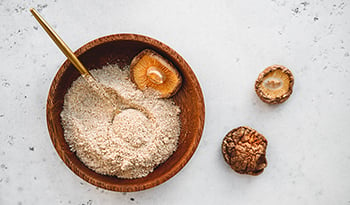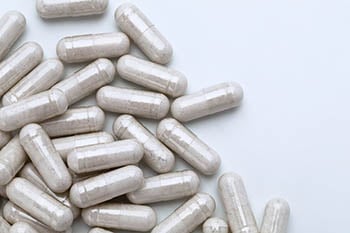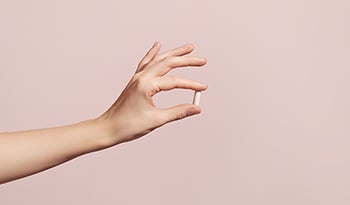5 Health Benefits of Echinacea
OŚWIADCZENIENiniejszy blog nie ma na celu diagnozowania...
- W tym artykule:
- What Is Echinacea?
- Echinacea Health and Nutrition Benefits
- Who Should Not Take Echinacea?
- Dosage
- Ways to Enjoy Echinacea
- How to Make Echinacea Tea
- How to Harvest Echinacea for Tea
- Takeaway

What Is Echinacea?
Echinacea, also known as purple coneflower, is an herbal flowering plant in the daisy family. Echinacea is a popular herb native to North America known for supporting immune health, reducing inflammation, reducing pain, and helping shorten the duration of the cold and flu.
The echinacea plant has a tall stem, a single purple or brown cone, white spikes resembling a hairbrush comb, and petals that are typically pink or purple, though they vary in color. Echinacea is commonly enjoyed as a tea. It can also be consumed in a capsule, tincture, or applied with a cream.
There are nine common and known types of echinacea. The three used in herbal supplements and remedies include:
- Echinacea angustifolia
- Echinacea pallida
- Echinacea purpurea
While Euro-American botanists recognized and began using echinacea for medical purposes in the 1820s, Native Americans have been using echinacea for more than 400 years. In fact, samples of echinacea have been found in archeological digs from Lakota Sioux village sites dating back to the 1600s.
Echinacea Health and Nutrition Benefits
Echinacea is a traditional medicinal herb that is high in antioxidants and phenols and has been used to help reduce anxiety, decrease the duration of the common cold and flu, and lower inflammation.
1. Echinacea Is High in Antioxidants
Echinacea is loaded with antioxidants, including flavonoids, cichoric acid, and rosmarinic acid. The flower, petals, and root of the echinacea plant have more antioxidants than the green leaves.
Antioxidants play an important role in human health by helping combat damage from free radicals. Eating a diet rich in antioxidants may help reduce the risk of diseases like heart disease. In addition to echinacea, other foods high in antioxidants include wild blueberries, pinto beans, cranberries, artichokes, blackberries, prunes, raspberries, strawberries, apples, pecans, sweet cherries, black beans, and dark leafy greens.
2. Echinacea May Help Reduce Symptoms of Anxiety
General anxiety disorder affects more than 6.8 million adults1. Studies suggest echinacea may help reduce anxiety symptoms due to its alkamides, rosmarinic acid, and caffeic acid2,3.
In one well-designed study, people with anxiety who took 40 milligrams of echinacea twice daily for seven days had significantly lower scores on a measure of anxiety compared to those who took a placebo.4
3. Echinacea Contains Phenols
Echinacea also contains phenols, compounds that combat free radicals and may help reduce the risk of chronic diseases and disorders related to oxidative stress, including cancer, cardiovascular disease, and neurodegenerative diseases5,6. Other foods high in phenols include purple grapes, berries, walnuts, coffee, chocolate, and green tea.
4. Echinacea May Help Reduce Inflammation
Studies suggest echinacea may also help reduce excess inflammation in the body7. Chronic inflammation can increase the risk of disease, pain, swelling, and more. Consuming anti-inflammatory foods and herbs like echinacea may help reduce diet-related inflammation within the body. Other foods that may offer anti-inflammatory benefits include turmeric, tomatoes, berries, avocado, grapes, dark chocolate or cacao, fatty fish, broccoli, green tea, mushrooms, peppers, and extra virgin olive oil.
5. Echinacea May Help Reduce Duration of the Common Cold and Flu
One of the most well-known uses for echinacea is to help shorten or reduce the duration of a cold or flu, though research results are mixed.8
Who Should Not Take Echinacea?
While echinacea has many benefits, some people should use caution when taking echinacea or avoid it altogether.
Those with any type of autoimmune disease should not take echinacea. This is because individuals with an autoimmune disease have an overstimulated immune system, and echinacea boosts or stimulates the immune system.
Additionally, people with diabetes, leukemia, liver disorders, multiple sclerosis, tuberculosis, HIV, AIDS, or taking immunosuppressants should not consume echinacea.
Drinking alcohol or smoking while consuming echinacea may impact echinacea’s efficacy. Echinacea may also interfere with how the body processes caffeine, prolonging caffeine’s effects9.
People who are pregnant or breastfeeding should be cautious when taking any supplements, including echinacea.
Though rare, some individuals may have an allergic reaction to echinacea, including rash, hives, or anaphylaxis.
Always consult your healthcare provider before starting a new supplement to be sure it is safe for you and won’t interact with any medications you are taking. When choosing supplements, look for trusted third-party certified brands for purity.
Dosage
While echinacea has been recognized as safe for short-term use, long-term daily use is not recommended10. Because no generalized dosage has been established, always purchase high-quality products from trustworthy brands and follow the serving size and instructions on the tea or supplement label.
If you have a cold or flu, talk to your doctor about taking echinacea up to three times daily until symptoms subside. Do not take echinacea for more than 10 days in a row.
Ways to Enjoy Echinacea
Echinacea is available in many forms, including:
- Herbal tea—bagged or loose-leaf
- Supplement
- Tincture
- Salve or topical cream
How to Make Echinacea Tea
To make echinacea tea using a tea bag, add the echinacea tea bag to a mug and pour hot water into the mug. Let the tea steep for five to 10 minutes, then enjoy.
If making a tea with loose leaves, strain or remove the parts of the plant before drinking. For an easy way to make loose-leaf tea, use a stainless steel tea infuser or teapot designed for use with loose leaves.
After steeping, the tea should taste sweet and mild. Steeping echinacea in hot water for too long may produce a strong, bitter taste.
How to Harvest Echinacea for Tea
Growing echinacea, also known as purple coneflower, is another way to enjoy echinacea right from your own backyard! The flowers are beautiful to look at and when in bloom, can be harvested, dried, and made into tea.
You can make echinacea tea from the flowers, leaves, stems, and roots—but avoid using the seed heads as they do not produce the same flavor. Incorporating the roots into your tea is an excellent way to increase the amount of tea you can brew from one plant. You can encourage new growth by cutting the blossoms at the base of the stem just above the first set of leaves. This allows the roots and one set of leaves to grow a new flower.
While you can make echinacea tea using fresh flowers, drying the flowers can make your echinacea tea last longer. Hang the purple coneflowers in a warm, dry area over a clean towel to catch the leaves and petals as they fall. Or simply lay the petals, leaves, stems, and roots directly on a towel. Let the echinacea petals, leaves, and stems dry until they can be broken up and crushed into small pieces. Store the dried tea in an airtight container made of glass or other nonreactive material. Keep it in a dry location out of the sunlight, such as a cupboard or pantry.
Brew your homemade echinacea tea at a ratio of 1 tablespoon dried echinacea to 10 ounces of boiling water. Steep the tea for five to eight minutes and enjoy!
Takeaway
Echinacea has been used for centuries for its potential health benefits, including supporting immune health, reducing inflammation, and shortening the duration of the common cold and flu. While it is safe for short-term use, long-term use isn’t recommended. You can enjoy echinacea as a tea, take it as a supplement or tincture, or use it topically as a salve.
As with all herbs and supplements, always consult your healthcare provider before incorporating echinacea into your wellness routine to be sure it is safe for you and won’t interact with any medications or other supplements you are taking.
References:
- Understand the Facts | Anxiety and Depression Association of America, ADAA. Accessed October 18, 2023.
- Lopresti AL, Smith SJ. An investigation into the anxiety-relieving and mood-enhancing effects of Echinacea angustifolia (EP107TM): A randomised, double-blind, placebo-controlled study. J Affect Disord. 2021;293:229-237.
- Haller J, Hohmann J, Freund TF. The effect of Echinacea preparations in three laboratory tests of anxiety: comparison with chlordiazepoxide. Phytother Res. 2010;24(11):1605-1613.
- Haller J, Krecsak L, Zámbori J. Double-blind placebo controlled trial of the anxiolytic effects of a standardized Echinacea extract. Phytother Res. 2020;34(3):660-668.
- Cosme P, Rodríguez AB, Espino J, Garrido M. Plant Phenolics: Bioavailability as a Key Determinant of Their Potential Health-Promoting Applications. Antioxidants 2020, Vol 9, Page 1263. 2020;9(12):1263.
- Brown PN, Chan M, Paley L, Betz JM. Determination of Major Phenolic Compounds in Echinacea spp. Raw Materials and Finished Products by High-Performance Liquid Chromatography with Ultraviolet Detection: Single-Laboratory Validation Matrix Extension. J AOAC Int. 2011;94(5):1400.
- Aucoin M, Cardozo V, McLaren MD, et al. A systematic review on the effects of Echinacea supplementation on cytokine levels: Is there a role in COVID-19? Metabol Open. 2021;11:100115.
- Karsch-Völk M, Barrett B, Kiefer D, Bauer R, Ardjomand-Woelkart K, Linde K. Echinacea for preventing and treating the common cold. Cochrane Database Syst Rev. 2014;2014(2).
- Gorski JC, Huang SM, Pinto A, et al. The effect of echinacea (Echinacea purpurea root) on cytochrome P450 activity in vivo. Clin Pharmacol Ther. 2004;75(1):89-100.
- Billah MM, Hosen MB, Khan F, Niaz K. Echinacea. Nonvitamin and Nonmineral Nutritional Supplements. Published online April 10, 2019:205-210.

 Autor: Megan Roosevelt, RDN
Autor: Megan Roosevelt, RDN


